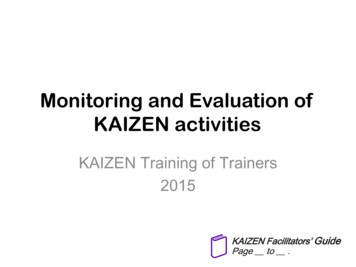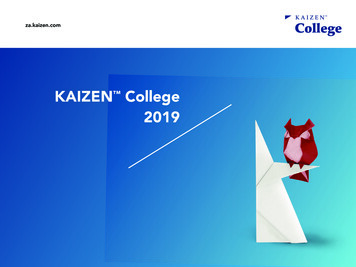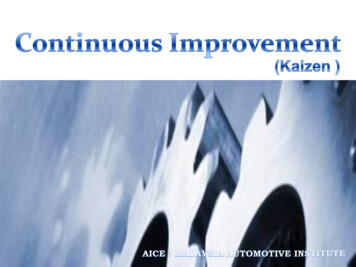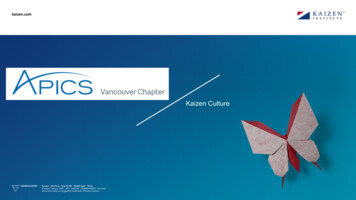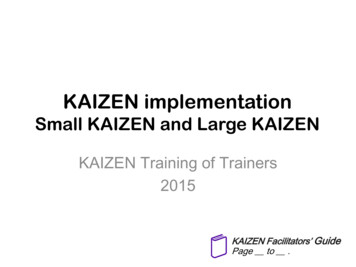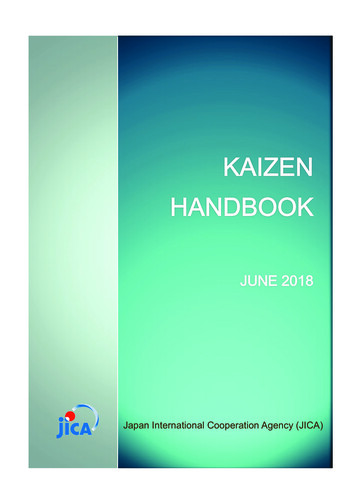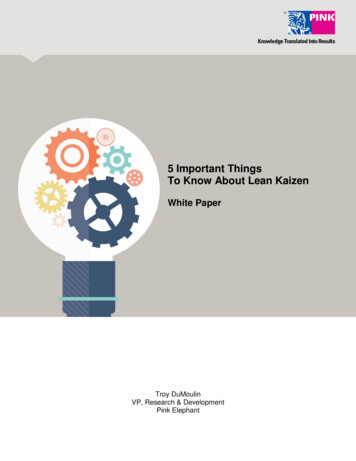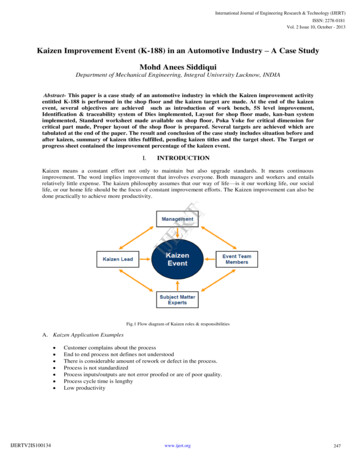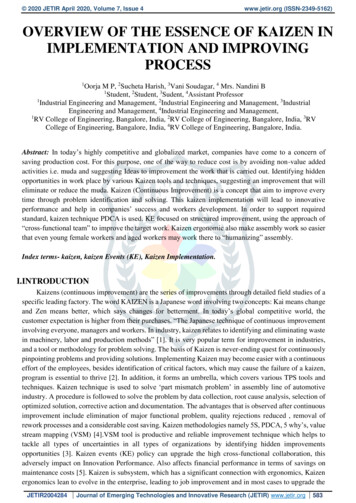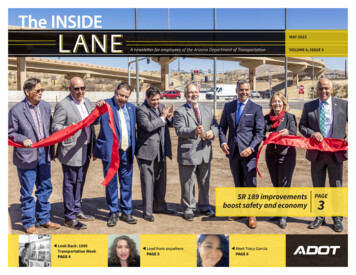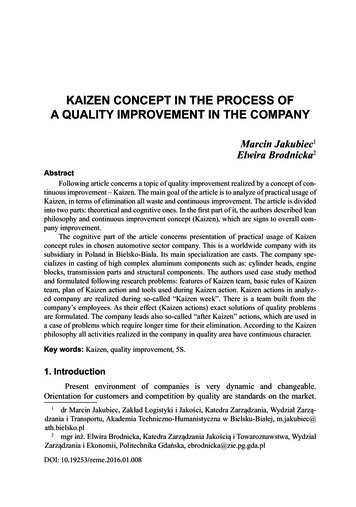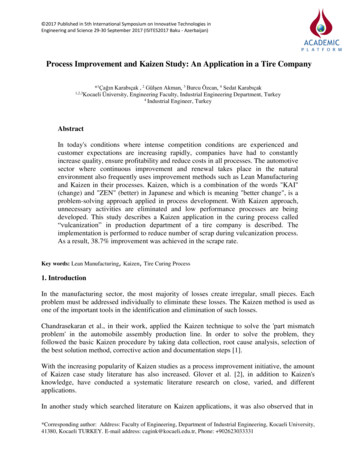
Transcription
2017 Published in 5th International Symposium on Innovative Technologies inEngineering and Science 29-30 September 2017 (ISITES2017 Baku - Azerbaijan)Process Improvement and Kaizen Study: An Application in a Tire Company1,2,3*1Çağın Karabıçak , 2 Gülşen Akman, 3 Burcu Özcan, 4 Sedat KarabıçakKocaeli Üniversity, Engineering Faculty, Industrial Engineering Department, Turkey4Industrial Engineer, TurkeyAbstractIn today's conditions where intense competition conditions are experienced andcustomer expectations are increasing rapidly, companies have had to constantlyincrease quality, ensure profitability and reduce costs in all processes. The automotivesector where continuous improvement and renewal takes place in the naturalenvironment also frequently uses improvement methods such as Lean Manufacturingand Kaizen in their processes. Kaizen, which is a combination of the words "KAI"(change) and "ZEN" (better) in Japanese and which is meaning "better change", is aproblem-solving approach applied in process development. With Kaizen approach,unnecessary activities are eliminated and low performance processes are beingdeveloped. This study describes a Kaizen application in the curing process called“vulcanization” in production department of a tire company is described. Theimplementation is performed to reduce number of scrap during vulcanization process.As a result, 38.7% improvement was achieved in the scrape rate.Key words: Lean Manufacturing, Kaizen, Tire Curing Process1. IntroductionIn the manufacturing sector, the most majority of losses create irregular, small pieces. Eachproblem must be addressed individually to eliminate these losses. The Kaizen method is used asone of the important tools in the identification and elimination of such losses.Chandrasekaran et al., in their work, applied the Kaizen technique to solve the 'part mismatchproblem' in the automobile assembly production line. In order to solve the problem, theyfollowed the basic Kaizen procedure by taking data collection, root cause analysis, selection ofthe best solution method, corrective action and documentation steps [1].With the increasing popularity of Kaizen studies as a process improvement initiative, the amountof Kaizen case study literature has also increased. Glover et al. [2], in addition to Kaizen'sknowledge, have conducted a systematic literature research on close, varied, and differentapplications.In another study which searched literature on Kaizen applications, it was also observed that in*Corresponding author: Address: Faculty of Engineering, Department of Industrial Engineering, Kocaeli University,41380, Kocaeli TURKEY. E-mail address: cagink@kocaeli.edu.tr, Phone: 902623033331
Ç.KARABIÇAK et al./ ISITES2017 Baku - Azerbaijan326terms of innovation, continuous improvements in Toyota over a certain period of time wereobserved on the basis of 7 cases, and it is expressed that Kaizen administration needed fororganizational design. For example, in Toyota, it has been found that not only the working teamsbut also the product / process design engineers contribute to Kaizen, and that the coordinationbetween the design and engineering departments is important [3].In a tire company operating in India, a waste management study was conducted to reduce theharmful effects by using lean manufacturing and Kaizen approach techniques. [4].This study was carried out in a tire manufacturing enterprise in an automotive subsidiaryindustry. Tire production consists of mixture, semi-finished product, tire building and curing. Inthis study, a problem which caused scrap and loss of production during the vulcanizationprocess, which is referred to as curing process in the tire sector manufacturing section, isinvestigated. The enterprise wants to use low-costed improvement opportunities by establishingsmall working groups in line with the basic principles of the Kaizen approach. The problem issolved by applying the Kaizen method with interdisciplinary team. With the performed Kaizenwork, a noticeable reduction in the scrap rate, breakdown caused machine standby andequipment changes has been achieved.As a result of researches on the business, one of the problems that are caused by the scrap is abreakdown which occurs during loading operation in the vulcanization phase before the curingprocess. In order to improve this breakdown, firstly trainings were given and then a team wasformed.2. Materials and MethodThe Kaizen term, which means "better change" in combination with the Japanese words "KAI"(change) and "ZEN" (better), is one of the problem-solving approaches used in processimprovement. In the current literature, Kaizen is often thought of as the accumulation of small,interdependent, progressive process innovations carried out by workers, working teams andleaders.This term comes from Gemba Kaizen and means 'continuous improvement' (CI). ContinuousImprovement is one of the core strategies for excellence in production and has vital importancein today's competitive environment. The Kaizen approach calls for that including everyone in theorganization for continuous development and improvement [5, 6].In Japan, Kaizen is used as slow progressing and constantly increasing improvement over time.In America, it is known as "Kaizen Blizt" or "Kaizen Events" as a gradual, regular systematicapproach for improvements [7].Womack and Jones [8] describe Kaizen as a part of lean production and indicate that they itreveals systematic approach to reduce waste.Kaizen practices have been the keys of lean implementation for many companies, and in
Ç.KARABIÇAK et al./ ISITES2017 Baku - Azerbaijan327Toyota's Regulations, the sentence “be ahead of time by means of infinite creativity, curiosityand development seeking. Has become a constantly emphasized thought [9].Slack defines Kaizen as the participation and mobilization of the worker in process improvementby creating a main channel for employees to contribute to the development and success of theorganization' [10].Kaizen is an approach that, starts with people, focuses its attention on people‘s efforts, processesare continually improved, improved processes will improve results, improved results will satisfythe customers [11].The Kaizen approach is generally expressed in six steps. These are discover improvementpotential, analyze the current methods, generate original ideas, develop an implementation plan,implement the plan and evaluate the new method [12]The steps of the Kaizen approach have been adapted for the implementation study as follows.1. Subject Selection: The reason for choosing the Kaizen topic is revealed by data.2. Team Building: The people to be involved in the Kaizen project are identified.3. Current Situation Analysis: The current situation analysis is performed to highlighthow the problem occurred and details are highlighted.4. Project Plan: The Kaizen Project Activity Plan is created, and the tasks andresponsibilities of the team and the project schedule are established.5. Analysis: Root causes and improvement areas are. The identified by appropriateproblem solving techniques (Cause Cause Analysis, Process Analysis, ParetoAnalysis, Comparison Matrix, etc.)6. Improvement: Suggested solutions applied related with the problem are included.7. Verification and Gaining’s: When it is confirmed to reach to target by questioningwhether the target has been reached, and the Kaizen annual return account isestablished.8. Standardization: Standardization methods (Instruction creation, company contracts,etc.) are taken in order to prevent backward movement.In this work carried out in an automotive supplier industry, the Kaizen steps mentioned abovewere applied. As a result of the researches carried out in the business, a breakdown whichoccurred during the tire loading in vulcanization phase was improved by applying the Kaizenmethod. While this improvement work was being put forward, basic problem solving tools wereutilized.3. ApplicationThis study was carried out on a set of quality, maintenance, manufacturing department staff andresearchers to reduce bladder folding breakdown in R17.5 curing machine in truck tiremanufacturing. In the study, 5 Why, Ishikawa diagram, Pareto chart, Gantt chart and Histogramtools are used. A regular meeting with the team was held on Wednesdays during 12 weeks.
328Ç.KARABIÇAK et al./ ISITES2017 Baku - AzerbaijanAfter training the team on the stages of Kaizen method and Kaizen concept, the aim and masterplan of the project were put forward. With the designated master plan, planned and actual timeswere followed. This plan shows the stage at which the project should occur in the week.14 Feb.13 Feb.12 Feb.11 Feb.10 Feb.12. Week7 Feb.6 Feb.5 Feb.4 Feb.3 Feb.11. Week31 Jan.30 Jan.29 Jan.28 Jan.27 Jan.10. Week24 Jan.23 Jan.22 Jan.21 Jan.20 Jan.17 Jan.9. Week16 Jan.15 Jan.14 Jan.13 Jan.8. Week10 Jan.9 Jan.8 Jan.7 Jan.6 Jan.7. Week3 Jan.2 Jan.1 Jan.31 Dec.30 Dec.6. Week27 Dec.26 Dec.25 Dec.24 Dec.23 Dec.20 Dec.19 Dec.18 Dec.16 Dec.13 Dec.12 Dec.11 Dec.10 Dec.9 Dec.6 Dec.5 Dec.4 Dec.3 Dec.2 Dec.29 Nov.28 Nov.27 Nov.5. WeekPlanPlanActuelPlanActuelPlan5. Set-up data collection systemActuelPlan1. Identify critical areasActuelPlan2. Perform Initial Cleaning and TaggingActuelPlan3. Manage the tagsActuel4. Define and implement cleaning, Inspection and Lubrication standartsPlanActuelPlan5. Restore all the Operating StandartsActuel1. Understand the root causes for recurring defect modes : 5 why analysis2. Attribute root causes to "machine, method, man and material" (4M)PlanActuelPlanActuelPlan3.Produce final QA Matrix from 5 whyActuelPlan1. Define action plan from step 3Actuel2. Standardise countermeasures by mean of OPLs and improved standarts4. Implementimprovement actionsPlanActuelPlan3. Introduce a training systemActuelPlan4. Record and plot resultsActuelPlan1. Organise the defect analysisActuelPlan2. Define the defect analysis procedureActuel5. Analyse every defectPlan3. Train all people on machine defects analysis procedure and formsActuel4. Implement the system & continuously folow up analyses and resultsPlanActuelPlan1. Define quality factors that guarantee the desired qualityActuel2. Create check lists and standarts to maintain the defined conditions6. Improve the qualitysystem to hold thegains4. WeekActuel3.List and describe defect modes4. Produce the QA Matrix and set the targets3. Find out root causesfor recurring defects3. WeekActuel2. Rank defect data and produce pareto graph2. Restore basicconditions on criticalareas and set standarts.2.WeekPlan1. The analysis of historical data.1. Identify the originsof defects26 Nov.25 Nov.1. WeekMaster Plan of Study17 Dec.Table 1.PlanActuelPlan3. Improve the reactivity to defectsActuelPlan4. Improve the control systemActuelPlan5. Set the Machine BoardActuelThe breakdown records in the Enterprise Resource Planning (ERP) program, was used todetermine the project subject with the team.1651611601127552586179F1182469506CF3 1.2241.550Figure 1 shows the distribution of scrap quantity based on the breakdown code in a given period.The breakdown which the team decided was a C3 breakdown. The reasons for selecting thesebreakdowns are listed below:- A single focal point of the breakdown- Visual inspection of the breakdown, easy to see- Missing sub-codes of the breakdownF3F10C6T9C7F13C3C13T5T4T12F9T8OtherFigure 1. Scraps quantities according to breakdowns codes in a given periodIn Figure 1, the number of scraps according to breakdown type of business. Breakdown types arecategorized by short codes. The numbers are taken from the ERP program used by the business.
329Ç.KARABIÇAK et al./ ISITES2017 Baku - AzerbaijanAs can be seen from the Figure 1, the scrap arising from the C3 breakdown is 1.7% of total scrap.The trend of the C3 breakdown is shown in Figure 20,020,0120150,030,030,030,020,020,010,012016 Jan-16 Feb-16 Mar-16 Apr-16 May-16 Jun-16 Jul-16 Aug-16 Sep-16 Oct-16 Nov-16 Dec-16 Jan-17Figure 2. Trend of C3 breakdownPareto Chart in Figure 3 show the trend of C3 scraps based on tire rim crust at a certain time. Asseen in the graph, 93% of C3 scrap is coming from R17.5 dimensions. The area to be focused isseen as the reason for this problem in R17.5 size.179167Total C3 Scrap 179 Pcs167 pcs from coming R17,5 sizesPcsTotal17,58422,519,5Figure 3. Trend of C3 breakdown on the basis of tire rimFigure 4 shows the distribution of C3 scrap quantities in presses which R17.5 size tires are cured.When the dispersion is examined, a machine where the breakdown is intensified is not seen.45292821Pcs167 pcs from different curing machines136076056126066099886604610611608
330Ç.KARABIÇAK et al./ ISITES2017 Baku - AzerbaijanFigure 4. C3 scrap quantity in press which R17,5 size tires is curedThe goal of the study is determined as to reduce number of C3 scrap from 179 units /year to 110units/year. When this target is provided, the loss of machinery and equipment that may occurwill be avoided and a profit of 15,000 euro / year will be provided.The breakdown rate at the initial stage of the work and the trend in the master plan werefollowed.0,070,06KPI [measure 010,010,0090,0080,010,010,006000010 -Fe b17 -Fe b24 -Fe b0sta rtKPI:WeekKPI ValueStarting pointTargetstart0,0250,0250,0125 -Nov25-Nov0,060,0250,0102 -Dec02-Dec0,030,0250,0109 -Dec09-Dec0,030,0250,0116 -Dec16-Dec0,0080,0250,0123 -Dec23-Dec0,0110,0250,0130 -Dec30-Dec0,0090,0250,0106 -Jan06-Jan00,0250,0113 -Jan13-Jan0,010,0250,0120 -Jan20-Jan0,010,0250,0127 -Jan27-Jan0,0060,0250,0103 -Fe ,0124-Feb00,0250,01OBJOBJ0,010,0250,01Cell to be filled manuallyFigure 5. Result Graph of Key Performance Indicator (Scrap Tyres)In the matrix in Table 2, the process steps and equipment and materials that could cause abreakdown are presented. These indications are created according to analysis result of teamemployees. Analyzes were created from entered explanations of breakdown reasons in the ERPprogram. Process step corresponding to each defect is graded. The matrix leads us to the phase inwhich the maximum problems occur.Table 2. Equipments and materials that can cause breakdown by process steps
Ç.KARABIÇAK et al./ ISITES2017 Baku - Azerbaijan331The photographs in Figure 6 show step by step tire curing process. First, the carcasses to be curedare brought in front of the curing machine. Then get the loader. After the machine is turned on,the loader takes carcasses into the machine. The carcasses are loaded on to bladder and bladdergets into the forming position. Thus curing process is started. The loaders go to their first positionand the machine becomes ready for closing position. The machine is closed and curing starts assoon as it is deemed appropriate by the operator.Figure 6. Steps of tire curing processIn photographs above Figure 6, the process steps are followed and the moment of occurrence ofthe breakdown is detected by the team. The breakdown occurs as a result of deformation of thematerial in the carcass bead area where the bladder set to the forming position. Figure 7 presentswires which should not be in a cured tire as result of this deformationFigure 7. Breakdown occurrence during process stepsThe Ishikawa diagram was created with the team members and the parameters that could causethe breakdown were classified. The ishikawa diagram is presented in Figure 8. These reasons aredefined as Bladder height is not enough, Not suitable ring is expressed as daimater, Incorrectpainting, Insufficient vacuum.
332Ç.KARABIÇAK et al./ ISITES2017 Baku - AzerbaijanFigure 8. Ishikawa diagram5 why analysis were made based on the items which are identified in Ishikawa diagram. Resultsof 5 why analysis are presented in Table 3.Table 3. 5 Why analysisFIVE WHY ANALYSISW ire appear on tyrebeadW ire appear on tyrebeadThere is not enoughvacuumIncorrect paintingNot enough tension onbladderOKInsufficient vacuumon the main line.The operator ismistakenDistant size isinsufficient.ActionsWhy (4)OKThe value of thespec is not true.stopUntrained operator.Why (5)CheckOKWhy (3)CheckW ire appear on tyrebeadWhy (2)CheckCreased BagWhy (1)CheckProblem DescriptionCheckPotential Causes4MPREVENTIVEACTIONEnvironmentalVacuum valuewill be calculate.ManOperators will betrainedMachineMil lengts will bechanged.CORRECTIVEACTIONstopMile length changedwhen manufacturing stopsystem changedThe result of the 5 why analysis showed that correct painting was not done, some errors werearised from the untrainedness of the operators, and the adjustment of the shaft size was required.4. ResultsAs a result of the analyzes, the team decided to make changes in the following subjects.- Bladder height should be changed.
Ç.KARABIÇAK et al./ ISITES2017 Baku - Azerbaijan-333Ring diameter should be changed.Standard painting.Stable vacuum.Correct compound thickness values.Training of operators.A standard measurement method is selected in order to close gap between measurement methodsof operators which is measuring distentional shaft inside length and operators which arepreparing.The photos of the changes performed are given in Figure 9. The performed changes werestandardized with Standard of Procedure (SOPs) and required trainings were given to operators.Figure 9. Photographs’ of performed changesGains of the study can be summarized as follows. As a result of the application aimed at reducingthe breakdowns that may occur during the vulcanization process, a 38.7% improvement in thebreakdown rate has been achieved in total. The scrap rate has been reduced, operators have beentrained, working instructions have been created and announced, and team motivation has beenprovided for further study. The return of the work done is calculated as 15,200 Euros per year.ConclusionsBusinesses use a variety of techniques, methods and tools to improve productivity and quality inthe long run by the aims of maximizing competitive advantage. As the internationalcompetitiveness increases especially in the automotive industry, many methods have beendevised to reduce production and raw material costs, to reduce waste and activities that do notadd value to the production process.Improving performance and improving workplace conditions by using Kaizen (ContinuousImprovement) methodology, which is one of these developed methods, has become a way forbusinesses to frequently resort to and achieve successful results.In this study; Kaizen application is carried out in a business. This business manufactures trucktire. Truck tire manufacturing process consists of mixture, semi-finished product, building andcuring stages. Kaizen application was performed in order to reduce a frequent breakdown in theproduction of tires of size R17.5 during the curing process. Scrap which occurs during loadingoperation and bladder folding defect were analyzed with a team including workers from different
Ç.KARABIÇAK et al./ ISITES2017 Baku - Azerbaijan334departments and researchers.As a result of the Kaizen application for the reducing breakdowns that could occur, breakdownrate was improved rate of 38.7% and the economic value was calculated as 15,200 Euros peryear.References[1] Chandrasekaran M, Kannan S, Pandiaraj P. Quality improvement in automobile assemblyproduction line by using Kaizen, Manufacturing Technology Today.2008: Vol. 7, No. 3: 38-33.[2] Glover WJ, Farris JA, Van Aken EM. Kaizen Events: Assessing the existing literature andconvergence of practices. Engineering Management Journal: 2014:26:61-39.[3] Iwao S. Revisiting the existing notion of continuous improvement (Kaizen): literature reviewand field research of Toyota from a perspective of innovation. Evolutionary and InstitutionalEconomics Review 2017: 4(1):59-29.[4] Gupta V, Narayanamurthy G, Acharya P. Can lean lead to green? Assessment of radial tyremanufacturing processes using system dynamics modeling. Computers & Operations Research2017:4:23-1.[5]Malik SA, YeZhuang T. Execution of continuous improvement practices in Spanish andPakistani industry: a comparative analysis. IEEE International Conference on Management ofInnovation and Technology, 2006: 2: 761-765.[6] Singh, J, Singh, H. Kaizen philosophy: A review of literature. IUP Journal of OperationsManagement, May 2009: 72-51.[7] Asaad MN, Saad R, Yusoff RZ. 5S, Kaizen and organization performance: examining therelationship and level of implementation using Rasch Model in Malaysian automotivecompany.International Journal of Business and Technology 2015:1(2):226-214.[8] Womack J P, Jones D T. Lean Thinking, New York: Simon & Schuster: 1996.[9] Kılıç A, Ayvaz B. Türkiye otomotiv yan sanayinde yalın üretim uygulaması, İstanbul TicaretÜniversitesi Fen Bilimleri Dergisi 2016:15(29):60-29.[10] Slack N, Chambers S, Johnston R. Operations Management, London: Prentice Hall FinancialTimes:2007.[11] Bhoi JA, Desai DA, Patel RM. The concept &methodology of Kaizen, International Journalof Engineering Development and Research 2014:2(1):820-812.[12] Kato I, Smalley A. Toyota Kaizen Methods Six Steps to Improvement, New York: CRCPress: 2011.
in today's competitive environment. The Kaizen approach calls for that including everyone in the organization for continuous development and improvement [5, 6]. In Japan, Kaizen is used as slow progressing and constantly increasing improvement over time. In America, it is known as "Kaizen Blizt" or "Kaizen Events" as a gradual, regular systematic
